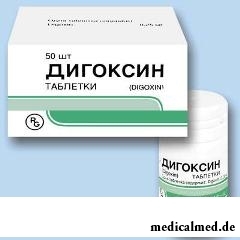





Digoxin
Application instruction:
 Digoxin – cardiotonic drug, cardiac glycoside.
Digoxin – cardiotonic drug, cardiac glycoside.
Form of release and structure
Dosage forms:
- Tablets: white or almost white color, a ploskotsilindrichesky form, with an engraving of "D" on one party and a facet (on 10 pieces in blister strip packagings, in a cardboard pack of 1, 2, 3, 5 or 10 packagings; on 50 pieces in polymeric or glass (dark color) banks, in a cardboard pack of 1 bank; on 50 pieces in blister strip packagings, in a cardboard pack 1 or 2 packagings; on 50 pieces in polypropylene bottles, in a cardboard pack 1 bottle; on 50 pieces in polypropylene cases, in a cardboard pack 1 case; on 25 pieces in blister strip packagings, in a cardboard pack 1, 2, or 4 packagings);
- Solution for intravenous (in/in) introductions (on 1 ml in ampoules: in a cardboard pack of 10 ampoules; on 5 pieces in blister strip packagings, in a cardboard pack 2 packagings).
Active agent – digoxin:
- 1 tablet – 0,25 mg or 0,1 mg (Digoksin children's);
- 1 ml of solution – 0,25 mg.
Auxiliary components as a part of tablets: lactose, sucrose, potato starch, calcium stearate, dextrose, talc.
Indications to use
Tablets
- Chronic heart failure of II (at clinical manifestations) and the III-IV functional class on NYHA classification – as a part of complex therapy;
- Blinking and atrial flutter of a chronic and paroxysmal current in a takhisistolichesky form, especially at the accompanying chronic heart failure.
Solution for in/in introductions
- Chronic heart failure at an atherosclerotic cardiosclerosis, dekompensirovanny valve heart diseases, a myocardium overload at arterial hypertension, especially at a constant form of an atrial flutter or a takhisistolichesky ciliary arrhythmia;
- Paroxysmal supraventricular arrhythmias (atrial flutter, ciliary arrhythmia, supraventricular tachycardia).
Contraindications
- Glikozidny intoxication;
- WPW-syndrome;
- Atrioventricular (AV) blockade of the II degree;
- The alternating total block;
- Breastfeeding period;
- Hypersensitivity to drug.
With care, comparing advantage of therapy and possible risk, it is necessary to appoint Digoxin at AV blockade of the I degree, an acute myocardial infarction, premature ventricular contraction, unstable stenocardia, a cardiac tamponade, the isolated mitral stenosis with the rare heart rate (HR), a renal and/or liver failure; to patients of advanced age.
Besides, contraindications to use of tablets:
- Age up to 3 years;
- Syndrome of glyukozo-galaktozny malabsorption, deficit of lactase, lactose intolerance.
With care patients with a sick sinus syndrome without pacemaker, risk of unstable carrying out on an AV node, heart failure with pathology of diastolic function (a restrictive cardiomyopathy, chronic cardial compression, a heart amyloidosis), the instruction on Morganyi-Adams-Stokes's attacks in the anamnesis, a hypertrophic subaortic stenosis, cardiac asthma against the background of a mitral stenosis (in the absence of a takhisistolichesky form of a ciliary arrhythmia), the arteriovenous shunt, the hypoxia expressed by dilatation of cardial cavities, a pulmonary heart take a pill; at an alkalosis, a hypothyroidism, myocarditis, obesity, and also a hypopotassemia, a hypomagnesiemia, a hypercalcemia, a hypernatremia.
Solution should be applied with care at the expressed bradycardia, ventricular tachycardia, a hypertrophic subaortal stenosis.
Use of Digoxin during pregnancy is appointed according to vital indications if the clinical effect for mother exceeds potential harm for a fruit.
Route of administration and dosage
Tablets
Pill is taken inside.
The dose is selected individually, being careful. For patients who before purpose of digoxin accepted cardiac glycosides the dose should be lowered.
The recommended dosing for patients is more senior than 10 years:
- Moderately bystry digitalization at the emergency therapy: a daily dose – 0,75-1,25 mg with frequency rate of reception 2 times a day (under control of an electrocardiography (ECG) before use of each subsequent dose). After achievement of saturation (24-36 hours) of the patient transfer to a maintenance therapy;
- Slow digitalization: 0,125-0,5 mg of 1 times a day within 5-7 days, after achievement of saturation pass to the supporting treatment;
- Maintenance therapy: the dose is established individually, usually – from 0,125 to 0,75 mg; the period of use the doctor, as a rule, appoints prolonged treatment.
For patients with chronic heart failure the daily dose should not exceed 0,25 mg, at body weight more than 85 kg – no more than 0,375 mg.
To patients of advanced age drug appoint 0,0625-0,125 mg in a dose.
At treatment of children of 3-10 years the sating dose is appointed taking into account the child's weight on 0,05-0,08 mg to 1 kg a day: at moderately bystry digitalization – within 3-5 days, a slow digitalization – 6-7 days, a maintenance dose – 0,01-0,025 mg on 1 kg a day.
Solution for in/in introductions
Solution is entered in/in kapelno or struyno.
The doctor appoints dosing individually, on the basis of clinical indications.
The recommended dosing:
- Moderately bystry digitalization – intravenously on 0,25 mg 3 times a day (then the patient is transferred to a maintenance therapy – in/in 0,125-0,25 mg of 1 times a day);
- Slow digitalization: to 0,5 mg a day (in 1-2 receptions);
- Paroxysmal supraventricular arrhythmia: a daily dose – 0,25-1 mg (in/in kapelno or struyno).
The sating dose for children – 0,05-0,08 mg on 1 kg of weight a day, at moderately bystry digitalization enter it 3-5 days, at a slow digitalization – 6-7 days. A maintenance dose for children – 0,01-0,025 mg on 1 kg of weight of the child a day.
Side effects
Side effects against the background of use of tablets often arise because of overdose and are symptoms of digitalis intoxication:
- Cardiovascular system: ventricular premature ventricular contraction; often – polytopic ventricular premature ventricular contraction, a bigeminal pulse, a ventricular Bouveret's disease, a sinus bradycardia, nodal tachycardia, sinoaurikulyarny (SA) blockade, AV blockade, trembling and atrial fibrillation, decrease in a segment of ST on an ECG with formation of a two-phase tooth of T;
- Nervous system: headache, sleep disorders, dizziness, radiculitis, neuritis, paresthesias, maniac-depressive syndrome, syncope; seldom – a disorientation, confusion of consciousness, one-color visual hallucinations (it is preferential at atherosclerosis at advanced age);
- Alimentary system: abdominal pains, nausea, vomiting, anorexia, diarrhea, intestines necrosis;
- Sense bodys: decrease in visual acuity, coloring in flavovirent color of visible objects, micro and a macropsia, flashing of "front sights" before eyes;
- System of a hemostasis and bodies of a hemopoiesis: nasal bleedings, Werlhof's disease, petechias;
- Allergic reactions: skin rash; seldom – a small tortoiseshell;
- Others: gynecomastia, hypopotassemia.
Solution for in/in introductions
- Cardiovascular system: AV blockade, bradycardia, disturbances of a cordial rhythm; isolated cases – thrombosis of mezenterialny vessels;
- Nervous system: feeling of fatigue, headache, dizziness; seldom – decrease in visual acuity, a xanthopsia, flashing of "front sights" before eyes, macro - and a micropsia, scotomas; isolated cases – sleep disorders, a depression, a syncopal condition, confusion of consciousness, euphoria, a delirious state;
- Alimentary system: nausea, vomiting, anorexia, diarrhea;
- Endocrine system: a gynecomastia (at prolonged use).
Special instructions
Digoxin should be applied under observation of the doctor, with regular carrying out an ECG, determination of level of content of electrolytes in blood serum.
Co-administration of drugs of a foxglove with parenteral administration of means of calcium is contraindicated.
At a chronic pulmonary heart, coronary insufficiency, disturbance of water and electrolytic balance, a renal or liver failure it is necessary to lower a dose, especially to patients of advanced age.
Patients with the broken secretory function of kidneys need to lower a dose of Digoxin: at the clearance of creatinine (CC) of 50-80 ml/min. – for 50% of a usual dose, KK is less than 10 ml/min. – for 75%.
With care it is necessary to make selection of a dose by the elderly patient as at this category of patients even at functional disorder of kidneys of KK can be within norm (at selection of a dose it is necessary to consider the level of concentration of digoxin in blood serum).
At the expressed renal failure (KK is less than 15 ml/min.) control of content of digoxin in blood serum it is necessary to carry out 1 time in 2 weeks.
At an idiopathic subaortal stenosis use of Digoxin causes increase of expressiveness of obstruction.
At a mitral stenosis cardiac glycosides are appointed at the accompanying right ventricular insufficiency or existence of a ciliary tachyarrhythmia.
With care blockade of the I degree should appoint at AV (treatment has to be followed by regular control of an ECG, if necessary – pharmacological prevention by the improving AV conductivity means).
The risk of glikozidny intoxication increases at a hypomagnesiemia, a hypopotassemia, a hypercalcemia, a hypothyroidism, the hypernatremia, a pulmonary heart expressed to dilatation of cardial cavities, myocarditis; at patients of advanced age. Therefore at purpose of digoxin the digitalization is controlled, using monitoring of its plasma concentration.
The patient has to be informed on obligatory implementation of the following recommendations:
- Not to change a dose independently;
- To accept drug every day in at one time;
- To see immediately a doctor at ChSS it is less than 60 beats per minute;
- At the admission of a dose to accept it at once as soon as remembered.
If the patient missed reception drug within more than 2 days or wishes to stop therapy it is necessary to report about it to the attending physician.
It is necessary to see a doctor at emergence of the speeded-up pulse, nausea, vomitings, a diarrhea.
At planned surgery or rendering acute management of the patient has to warn the doctor about Digoxin reception.
Patients with contact lenses during treatment should exclude their use.
Simultaneous use of other means without the permission of the doctor is undesirable.
Content of sucrose, lactose, potato starch, glucose in 1 tablet corresponds to 0,006 grain units.
It is necessary to be careful at control of vehicles and mechanisms.
Medicinal interaction
The risk of development of toxic effect of Digoxin increases at simultaneous use with calcium drugs, diuretics, insulin, glucocorticosteroids, B Amphotericinum, beta-adrenergic agonists and other means causing disturbances of electrolytic balance in this connection the drug dose at appointment should lower and be not to allowed in/in administrations of salts of calcium.
At a combination to Triamterenum, Spironolactonum, quinidine, Amiodaronum, blockers of slow calcium channels, especially verapamil, the content of digoxin in blood serum increases.
At simultaneous use of Digoxin:
- Colestyraminum, колестипол, Neomycinum, tetracycline, purgatives, Sulfasalazinum, Neomycinum, phenylbutazone, the antacids (containing salts of aluminum, magnesium), a kaolin, pectin and other adsorbents – reduce its absorption in intestines, concentration in blood and medical action;
- Absorbent carbon, drugs of the St. John's Wort which is made a hole a kaolin, astringents, Sulfasalazinum, Metoclopramidum, прозерин – reduce bioavailability of drug;
- Erythromycin, antibiotics with a broad spectrum of activity – increase bioavailability of Digoxin;
- Barbiturates, Phenytoinum, phenylbutazone, rifampicin, oral contraceptives, antiepileptic means (inductors of a microsomal oxidation) can exponentiate digoxin metabolism;
- Sodium phosphate, glyuko-and mineralokortikosteroida, karboangidraza inhibitors, B Amphotericinum, adrenocorticotropic hormone (AKTG), Acidum etacrynicum, буметанид, furosemide, Mannitolum, индапамид, derivatives of a tiazid – can reduce therapeutic effect and promote development of side effects of drug;
- Edrofoniya chloride – raising a tone of a parasympathetic nervous system, can lead to the expressed bradycardia;
- Quinine, quinidine – lead to sharp increase in concentration of digoxin;
- Indometacin, Spironolactonum, captopril, blockers of slow calcium channels – slow down digoxin removal, increasing risk of toxic influence of drug;
- Hormones of a thyroid gland – strengthen a metabolism in an organism (obligatory increase in a dose of digoxin is required);
- Heparin – decreases its anticoagulating action;
- Antiarrhytmic means, pankuroniya bromide, calcium salts, Rauwolfia alkaloids, sympathomimetics, succinylcholine iodide – can cause disturbance of a cordial rhythm;
- Amiodaronum – increases to toxic level the content of digoxin in a blood plasma (cancellation or a dose decline of digoxin is shown twice).
Apply sulfate magnesium solution to decrease in toxic influence of cardiac glycosides.
Digoxin distorts the researches of perfusion of a myocardium given when carrying out using thallium of chloride (201 TI), reducing extent of its accumulation in points of damage of a cardiac muscle.
Terms and storage conditions
To store in the place protected from light at a temperature of 15-25 °C. To protect from children.
Period of validity: tablets – 2 years, solution – 5 years.
Name of drug
Price
Drugstore
Digoxin тбл 250 mkg No. 50 **, Gedeon Richter-RUS of closed joint stock company
51 rub.
 Network of the Moscow drugstores of IFC
Network of the Moscow drugstores of IFCDigoxin тбл 250 mkg No. 56, Updating of CJSC PFK
68 rub.
 Network of the Moscow drugstores of IFC
Network of the Moscow drugstores of IFCMost of women is capable to derive more pleasure from contemplation of the beautiful body in a mirror, than from sex. So, women, you aim at symmetry.

Subfebrile temperature call fervescence to 38 degrees, and subfebrile condition - existence of such temperature from above...
Section: Articles about health
Practically each person is familiar with the annoying, pulling, unscrewing pains caused by overcooling of muscles of a back. In certain cases inflammatory process is not limited to discomfort, being followed by emergence of hypostasis, consolidations, increase температ...
Section: Articles about health
Stability of a hormonal background is one of the most important conditions of preservation of health of the woman. At the same time endocrine system – the thin device extremely sensitive to any external influences. Changes of a way of life (for example, a diet), emotional stresses, infectious diseases, reception of some drugs can become the reason of hormonal failure. Besides, work of hemadens has the natural specifics in certain moments of life: on various St...
Section: Articles about health
There is an opinion that at low temperatures safety of products is ensured longer and better thanks to what the refrigerator considers...
Section: Articles about health
Popular joke that there are no healthy people, and is nedoobsledovanny, most of us considers an honest truth, continually it is necessary to hear that all of us are sick hardly from a school bench. It is hard to say, whether so it actually because...
Section: Articles about health
Musicotherapy – a treatment method which caused and causes a set of a controversy concerning its efficiency. However the facts are relentless: during the numerous researches curative impact of music on an organism was scientifically confirmed. Since then in a number of the countries the technique is included complex therapy of diseases of cardiovascular and respiratory system, dorsodynias and a backbone, psychosomatic disturbances and many other illnesses. The musicotherapy in a pedi is especially widely applied...
Section: Articles about health
What they, women? Beautiful, gentle, passionate and at the same time windy, gusty, and nervous. And what is stranger: all эт...
Section: Articles about health
80% of women at least once to lives complained of discomfortable feelings to breasts, consolidations and nagrubaniye. These are mastopathy symptoms. The mastopathy is characterized by change of a ratio between ferruterous and connective tissue tissues of mammary glands. It can bring...
Section: Articles about health
The technique of acupuncture (acupuncture) is used in the medical purposes more than three and a half millennia. It is eurysynusic and recognized as official medicine in the majority of the developed countries of the world. Influence by fine needles on so-called points of acupuncture contributes to normalization of a metabolism and hormonal background, activates protective forces of an organism, has anesthetic and antiinflammatory effect, stabilizes a condition of mentality....
Section: Articles about health
We live during an advertizing era. Daily each person receives a solid portion of persuasive councils about what to eat to be здо...
Section: Articles about health
Radiological methods of a research are applied in medicine more than hundred years, and thanks to them millions of lives were saved. In many cases without X-ray it is impossible to make exact idea of a condition of bodies and fabrics, it is correct to make the diagnosis. Those...
Section: Articles about health
The person, as well as all other beings living on our planet feels weather changing. It is the normal meteosensitivity which is not causing to healthy people of special troubles. Meteodependence, on the contrary, is the morbid condition which is characterized by an exacerbation of chronic illnesses at change of air temperature, differences of atmospheric pressure, wind strengthening, magnetic storms and other "surprises" on which the nature is so generous. The people suffering from meteodependence have to з...
Section: Articles about health
History of use of an anesthesia during operations contains more than 160 years. Annually in the world hundreds of thousands surgical вм are carried out...
Section: Articles about health
Several decades ago the basil (the district khan, реан, Reagan) was considered as a part of the Caucasian or east cuisine, but today it strongly took the place on tables of Russians. Greens of this plant possess a strong, pleasant smell and specific fresh taste, because of to...
Section: Articles about health
Household skills which to us so diligently imparted in the childhood it appears, not always bring only benefit. According to results of the last researches, some habits which for a long time were considered useful and even necessary can become the reason of serious indispositions. Here only seven the most widespread of them....
Section: Articles about health
Doctors claim that the people not so familiar with a dorsodynia occur among adult Russians very seldom. At the same time подавляющ...
Section: Articles about health
All of us, unfortunately, should face flu nearly an every year. It would seem, so frequent disease has to be studied already up and down, and each person, at least once by it had (and the number of such people in our country aims at 100%), a dolzha...
Section: Articles about health
Life of the modern woman is very difficult. Opportunities to realize itself are wide: it not only education and career, but also the most various hobbies from sport before needlework. It is not less important to build private life, paying an attention maximum to children, the husband, parents, friends. For all these affairs there is catastrophically not enough time therefore each of us tries to cut down as far as possible its expenses on necessary, but not the most fascinating housework. With it we are successfully helped by means...
Section: Articles about health
Dark circles (bruises) under eyes – a shortcoming with most of which often fight against the help of cosmetics (proofreaders, salons...
Section: Articles about health
Summer in the heat. Many are going to spend vacation abroad. Travelers the tender seas, rest on beaches wait, for sightseeing, campaigns on natural and cultural reserves. But, unfortunately, on vacation also problems about health can wait for us...
Section: Articles about health
Health and attractiveness - eternal values, pursuing which people often use the most unusual ingredients and technicians. Let's consider 11 most exotic and sometimes not most pleasant Spa procedures to which the person in a pursuit of beauty and youth agrees....
Section: Articles about health
On health of the person physicians know about salutary action of animals long ago. About 7 thousand years ago great Hippocrates рекоменд...
Section: Articles about health
The naturopathy sometimes moves as the new direction of medicine, something like fashionable hobby, and there is nothing farther from the truth. This most ancient direction, the word "naturopathy" is translated as "treatment by the nature", and, no doubt, treatment приро...
Section: Articles about health
The advantage of swimming for the person is so high that this sport is not only the most popular, but also is widely applied in medicine and rehabilitation processes. If you look for for yourself the occupation allowing pleasantly and to spend time, then swimming with advantage – the fact that it is necessary for you. And give learns several facts about swimming....
Section: Slideshow
Small appetite at the child – the complaint which pediatricians should hear practically from each mother. Most often it is carried to разр...
Section: Articles about health
The problem of diagnosis was and remains to one of the most important in medicine. From that, the reason of an indisposition of the patient will be how precisely defined, eventually success of treatment depends. In spite of the fact that the majority of the diagnostic methods applied in about...
Section: Articles about health
About 20% of the population of our planet have a hypertension (permanent increase in arterial pressure). This disease has an adverse effect on the standard of living, reduces working capacity, and in the absence of systematic treatment threatens with such complications as a myocardial infarction, a stroke and other heavy illnesses which can result in disability or sudden death. Most of patients for maintenance of pressure at more or less acceptable level accept appointed doctors лекарст...
Section: Articles about health

